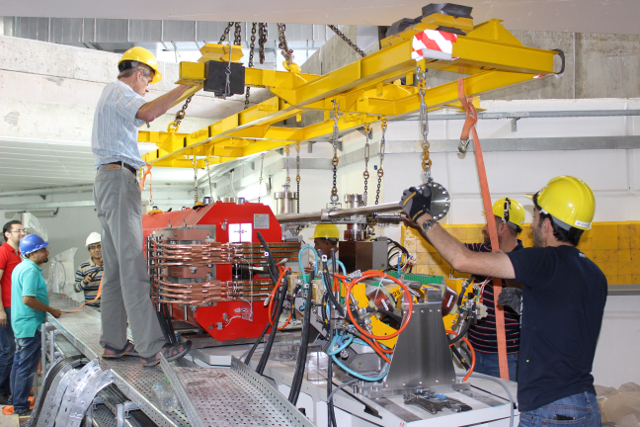The SESAME Particle Accelerator: A Symbol for Cooperation in the Middle East

Workers install equipment at the SESAME particle accelerator in Jordan, which opened in May 2017. Photo: SESAME
SAN FRANCISCO—Science can bring us together in unexpected ways. Charles Darwin, for instance, figured out that we are all related to a common ancestor; James Watson and Francis Crick discovered that all organisms share the same genetic language, DNA.
Today, a particle accelerator is playing the same role for scientists in the world’s most conflicted region. SESAME, a high-energy physics facility in Jordan, has drawn together researchers from Israel, Palestine and Iran, among other political rivals.
After helping the laboratory start operating in May 2017, three SESAME researchers spoke on 27 October in a session at the World Conference of Science Journalists 2017. They explained their projects and told the story of the first major international research center in the Middle East.
SESAME (“Synchrotron-light for Experimental Science and Applications in the Middle East”) is an accelerator in the Al Balqa region of Jordan. This experiment boosts subatomic particles to extreme velocities, reaching energies up to 2.5 giga-electronvolts (GeV)—generating x-rays as powerful as those in many world-class facilities.
Two Iranian physicists who were part of the SESAME collaboration died in terrorist explosions in 2010.
SESAME faces many challenges. Funding is scarce and recent international conflicts still haunt its operations. In 2010, tensions increased when terrorist explosions killed two Iranian physicists who were part of the SESAME collaboration, attacks for which the Iranian government blamed Israel.
In spite of these problems, Iranian physical chemist Maedeh Darzi explained that one of the most valuable things about this project is its symbolic meaning. “We need SESAME not only because of its scientific value, but because we need to show that we can work together,” she said.
A multidisciplinary endeavor
Unlike the world’s biggest particle accelerator at CERN in Geneva, Switzerland, SESAME doesn’t focus on fundamental particles and their interactions. Instead, it uses synchrotron light—intense x-rays and other radiation produced by the electrons as they accelerate around a confined ring—to study phenomena in diverse fields ranging from neurobiology to archaeology.
“The synchrotron has evolved from a playground for physicists to a multipurpose scientific facility,” said archaeologist Kirsi Lorentz of The Cyprus Institute. “It is useful for any discipline in science, including human bioarchaeology.”
For instance, Lorentz uses the SESAME beamline to delve into our anthropological origins—“the cradle of civilization,” as she calls it. Since archaeological remains are so fragile, her team uses synchrotron light to analyze human cadavers from ancient cultures in the Middle East.
Now, scientists don’t need to spend hours traveling to a European synchrotron.
In other words, this type of light allows scientists to examine biological remains with an incredible degree of precision—and without damaging the samples. This was not possible in this region of the world until now.
SESAME also lowers the cost of doing research in the Middle East. Now, scientists don’t need to spend hours traveling to a European synchrotron. “In Tel Aviv, to do these experiments we [had] to hop on planes, and that really limited the possibilities of several experiments that we could do,” said biophysicist Roy Beck-Barkai of Tel Aviv University in Israel. “SESAME is extremely important for us.”
Science over politics
It’s hard for SESAME to escape its political context. Since private donations are scarce, almost all of the funding comes from government sources.
“We’re not there as ambassadors of our country,” Beck said. “We’re scientists. Although when politicians see that we can work together, that has an impact.”
The support of the Jordanian government has been crucial, since it’s the only one with diplomatic relations with all nine members of the SESAME consortium: Iran, Pakistan, Israel, Turkey, Cyprus, Egypt, the Palestinian Authority, Jordan and Bahrain.
Also, the scientific council of CERN has served as an important mediator between the Middle Eastern countries. It helped create the Middle Eastern Scientific Cooperation group in 1995 and, more recently, helped structure SESAME’s scientific council and provided necessary equipment.
SESAME’s first scientific papers have already been published, but Beck and his colleagues expect a wave of new studies as soon as the synchrotron gets more beams running. The best of SESAME is still to come.
—
Sebastián Rodríguez is an undergraduate in communications with a major in journalism at the Universidad de Costa Rica. He is a contributor to the weekly journal “Semanario Universidad” in its climate change section, called “Ojo al Clima“. He also contributes to the communications team at the Interamerican Association for Environmental Defense. Write to Sebas at sebas211297@gmail.com.
